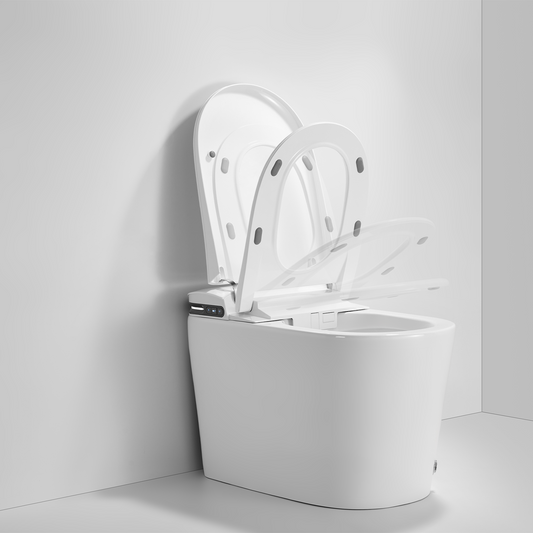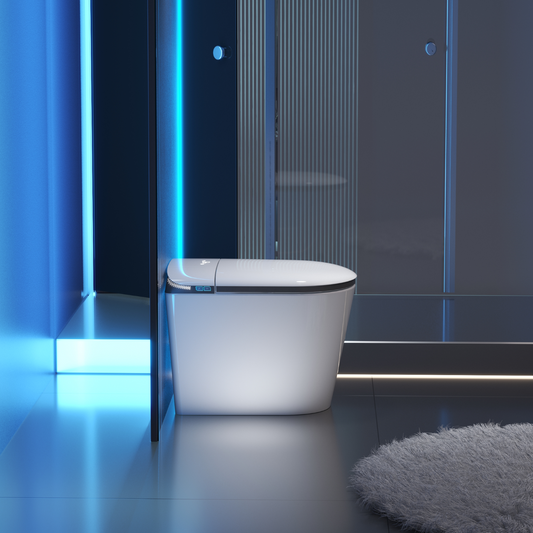How to Define a Smart Toilet
The concept of a smart toilet can be traced back to the 18th-century bidet or bidet shower, a handheld nozzle used for cleaning the buttocks. Clearly, this can't be considered smart, as "smart" in consumer perception means automation rather than manual operation. However, it did lay the foundation for the design concept of modern smart toilets. The first truly smart toilets appeared in the 1980s and gradually gained popularity. Initially known as electronic bidets, their primary function was buttocks cleaning.
As time progressed, this simple operation could no longer satisfy people's needs. Unlike the early versions, modern smart toilets have achieved significant advancements in functionality. These toilets integrate multiple smart features, including automatic lid opening, seat heating, warm water cleaning, and warm air drying. These features allow users to almost entirely avoid manual operation during use; aside from pulling down and pulling up their pants, the smart toilet can virtually perform all cleaning and comfort tasks automatically.
Current State of the Smart Toilet Market
The smart toilet market is steadily growing, mainly due to the younger generation's increased acceptance of buttocks cleaning functions. As this demand grows, more and more speculators realize the market's potential and enter the field. This trend will ultimately benefit consumers, not only by offering products at lower prices but also by providing more choices in styles and functions. Currently, some outstanding smart toilet brands have emerged in the market, such as YBS BATH Home, known for its cost-effectiveness, Toto, which targets the high-end market, and Kohler, known for its innovative designs.
Although the market is generally positive, there are still challenges. Some low-tech manufacturers quickly launch new products by copying designs, which affects brands focused on product quality and may lead to a decline in consumer confidence in smart toilets.
Therefore, future smart toilet manufacturers should adhere to innovation, focusing on unique designs and robust features to provide more high-quality products to the market. The ideal vision is to achieve product customization to meet diverse consumer needs, allowing users to personalize their smart toilets according to their preferences and requirements.

BUY IT NOW
Areas for Improvement in Smart Toilets
Despite the impressive functionality of smart toilets, there is still room for improvement to achieve a smarter, safer, and more hygienic user experience. For example, material upgrades are an important area for improvement. Taking Giving Tree Home as an example, we use non-porous ceramic materials in the main structure of our smart toilets to help prevent the growth of bacteria and mold. For the toilet seat cover, we offer two eco-friendly materials: PP and ABS. PP is lighter, but for users with higher demands, we recommend the ABS cover due to its better flame retardancy and corrosion resistance. In the future, we plan to gradually upgrade PP covers to ABS to further enhance product quality.
Regarding the internal structure, smart toilets mainly come in two types: tankless and tank designs. Tankless smart toilets can flush and clean faster without waiting for water storage, but they require compatibility with household water pressure. High water pressure may cause damage, while low water pressure may result in incomplete flushing. Although this issue is unrelated to smart toilet quality, it can indeed be troublesome. Therefore, we are continuously improving our customer service to help users address water pressure issues. On the other hand, smart toilets with tanks are not affected by water pressure, but they may require a few seconds to store water. To address this, we are working on improving the water tank's storage speed to minimize waiting time as much as possible. The best solution is to offer both structures for the same product, clearly outlining their respective advantages and disadvantages, allowing users to choose based on their needs.
For elderly users, frequent nighttime trips to the bathroom can be disruptive, especially when bright lights or noise disturb their sleep. We address this concern by introducing quiet flushing and night light features in smart toilets, automatically performing these operations to avoid disturbing users' sleep while ensuring safety and hygiene.
Ending
Although the points mentioned above only touch on some superficial improvements, the future holds vast potential for the further advancement of smart toilets, both in terms of industry development and technological breakthroughs. Higher degrees of automation, rapid fault diagnosis and repair, and more competitive price optimization are all directions worth anticipating. However, it is evident that the industry is moving in a positive direction. With continuous technological advancements, we have every reason to believe that future smart toilets will achieve significant breakthroughs in functionality and quality, bringing unprecedented convenience and comfort to consumers.
PREVIOUS POST
Everything You Need to Know About Clawfoot Bathtub
NEXT POST
How to Choose the Bathtub Inclination Angle





